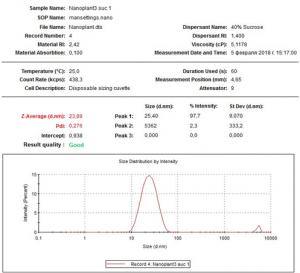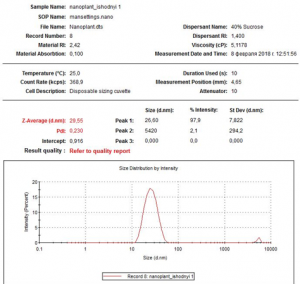Aim of the study: to study the decomposition of Nanoplant nanoparticles in soil and water
Research location: Belarusian National Academy of Sciences, Institute of Experimental Botany and Institute of Physical-Organic Chemistry of the Belarusian National Academy of Sciences, Minsk, Republic of Belarus
Object of the study: Nanoplant solution of nanoparticles stabilized by natural (starch) polymer of different types of microelements (Co, Mn, Cu, Fe, Zn, Cr, Se, Mo, Ag)
Developer: Institute of Physical-Organic Chemistry, Belarusian National Academy of Sciences, Minsk, Republic of Belarus
The study consists of two stages:
Stage 1
Aim: To find out how long the nanoparticles in Nanoplant fertilizers get into the soil and water, and remain stable.
Investigation progress:
- Prepare Nanoplant working solution (DT) – 2 drops to 200 ml of water (corresponding to DT 100 ml / 300 l);
- The prepared DT performs a nanoparticle test (Malvern ZETASIZER NANO). Figure 1 shows that the solution contains stable nanoparticles with an average size of about 25 nm.

Fig. 1 Working solution to contact with soil
3. DT is placed in a container with soil, covered and left at room temperature for two weeks.
4. After two weeks, the soil is removed from the tank and the liquid is filtered off.
5. We perform analysis of nanoparticles in liquid. Picture no. 2 we see that nanoparticles have not been detected yet.

Fig. 2 Working solution after two weeks of contact with the soil
Conclusion: After 2 weeks, no nanoparticles in the Nanoplant fertilizer soil are detected. They are consumed by micro-organisms in the soil and transformed into naturally occurring minerals.
Stage 2
Aim: To find out if micro-organisms in the soil are using nanoparticles in Nanoplant fertilizers
Investigation progress:
- A large amount of water from the available soil sample is “plove” microorganisms.
- From the resulting mass we separated the liquid part together with the microorganisms contained therein.
- In the resulting “extract” of microorganisms, we performed a nanoparticle stability analysis and placed in a container with a favorable medium for microorganism growth. Figure 3 shows that the solution contains stable nanoparticles with an average size of about 26.6 nm.

Fig. 3
4. After one week, we performed repeated analysis of the nanoparticles in the microorganism “extract”. Figure no. 4 shows that the amount of nanoparticles has dropped significantly (peak on the left side of the graph), but a second peak with significantly larger particles (above 200 nm) appeared. It is a part of the microorganisms captured by the device.

Fig.4
5. After the second week, we performed another repeated analysis of the nanoparticles in the “extract” of microorganisms. Picture no. 5 shows that the Nanoplant nanoparticles have completely disappeared, retaining only larger particles with a high peak of “rich” microorganisms.

Fig.5
Conclusion: As we can see from this two-part study, nanoparticles in Nanoplant fertilizer remain stable in soil and water for 2-3 weeks. Later, even their traces remain, because the microorganisms in the soil completely recycle them.